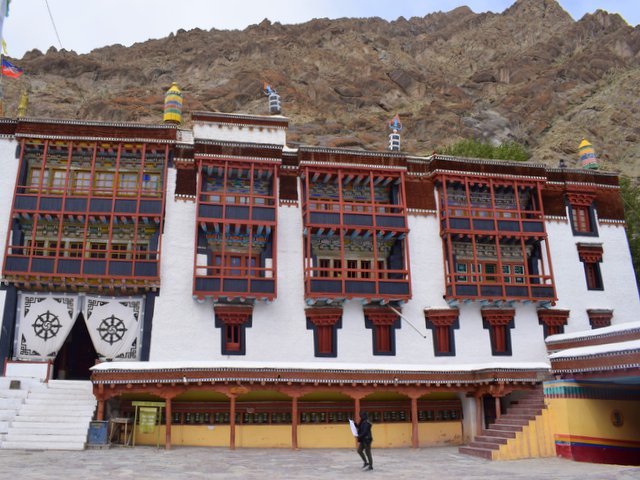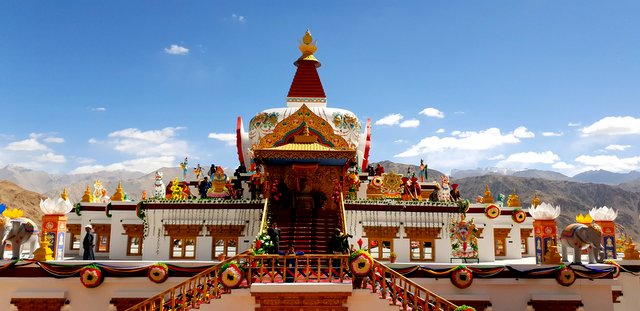Hemis Monastery cradles the finest relics of Buddhist culture that thrived in Central Asia for millennia. Standing tall in the folds of arid deserted highlands of the Ladakh Himalayas, it is the sacred religious hermitage that lives on the blessings of Naropa. An ancient Buddhist scholar, Naropa presided over the operations of Nalanda Mahavihara as a chancellor!
Where is Hemis Monastery?
Situated at a distance of 45 KM from the town of Leh. The monastery has survived many invasions, embedded in the history of Central Asia, that rocked the region. You will not be able to spot the monastery until you have reached the foot of the mountain and ventured into the interiors. It is mostly invisible to the outer world!

A hidden world of wisdom, ancient culture rich with artifacts dating back to the Gandharan period. It truly opens up as you enter the Hemis Monastery premises. As you start to explore the area, you realize that it has largely remained nonchalant to the technology evolution changing the face of the modern world.
And yet, the monastery would not want to thrive in the impactful influence it has on the locals and the regional followers of Buddhism. In fact, it has opened its door to the world. It is inviting pilgrims, researchers, and visitors from around the globe. To share the rich heritage and cultural safe-keeps in the form of religious scriptures and folklore! Naropa Festival is a prime example of the endeavor!
Sustainable Tourism initiated by Drukpa Thuksey Rinpoche in Ladakh
His Eminence Drukpa Thuksey Rinpoche, one of the prime authorities of the monastery has initiated many programs that will ensure sustainable tourism in the locality. It works to guard the peace that prevails in the mountains despite being in a conflict zone. And uplift the local people of the region. All this has a positive impact on the lives of local youth.

Naropa Festival is a successful confluence of people following many faiths and lifestyles. Be it from the remote villages of Ladakh or the mountains of Bhutan or the plains of India. In a couple of days’ time, we met environment enthusiasts, religious scholars, artists, and more. All of them were passionate about bringing change for betterment!
River Indus
As you proceed towards Hemis from Leh in the wee hours of the day, you will come across the magnificent river Indus. It is fascinating to look at the flow of the Indus that has been synonymous with the identity of Indians! A lot of monasteries are situated by the river Indus, atop the mountains.
Read More – Mini Road Trips from Leh to See Ladakh
The willow, the poplar trees, the bend of the river, and the small villages built on the hilltops. Together they make beautiful landscapes, befitting the appearance of an oasis in the arid mountainous region of Ladakh! We learned the tree plantation was an initiative taken up by the Drukpas from the monastery, adding a dash of green to the area.
Naropa Festival at Hemis Monastery
We visited the monastery for a couple of days during the festival. Truth be told if you love to delve deep into the culture of the region, you need to frequent this area many more times. Be rest assured, every visit will be a fulfilling learning experience. From the highway, it looks like a three-tiered institute.

There is an Indus river at the bottom, from the banks of which a serpentine road goes to the entry gate of the monastery. A newly built ivory-white Naropa Stupa, Naro Photang, adorned with wood carvings is situated by the side of the road. The Naropa Festival takes place here.
Go up the winding road for another couple of kilometers and you shall come across the beautiful monastery made of clay and mud bricks. It retains the old-world charm to a large extent!
Hemis Monastery of Drukpa

Following a religious sect of Tibetan Buddhism under the Drukpa Lineage, Hemis monastery dates back to antiquity. In the year 1672, the Ladakhi emperor Sengge Namgyal restored the glory of the monastery. It is one of the primary seats of Tantrik Buddhism. Many myths arguably suggest Jesus had spent the last of the “far east days” in this monastery.
The mystic mask dance, ancient manuscripts, handpainted murals, and incense sticks inside the Gompas tell stories from the days bygone. No wonder, it is conferred to be one of the richest Buddhist monasteries of the Ladakh region. The main complex is a two-story building, made of typical Ladakhi wooden fixtures on the mud-brick wall, painted in yellow and maroon, the color of the monks’ robes!
Read More – Cham Dance of Himalayan Monasteries
Make sure you explore the lamp room where yak butter is used to illuminate different shapes of lamps. Some burning for the entire year round, some only for a night. They are believed to be reminiscing about the deceased monks and holy spirits. Visitors can enter three gompas and observe the monks offering worship to different incarnations of Buddha and his disciples. The most prominent of them is the statue of Guru Padmasambhava, the legendary “second Buddha” according to the Tibetan school of Buddhism.
The sprawling courtyard of the monastery also acts as the stage for the famous Hemis Tsechu festival on the 10th day of the Tse-Chu, the Lunar month of the Tibetan Calendar, and celebrates the birth of Guru Padmasambhava.
Museum
On the other side of the courtyard is housed the fantastic Hemis Museum. Contrary to my apprehensions, this tiny museum is rich in relics, artifacts, and historical documents. It is like a walk through the history of the monastery since the dawn of civilization.

You can see Gandharan-style statues dating back to the time of Alexander displayed beside the Black and white portrait of the Tsechu Festival. An adult snow leopard skin is hung on display which used to be a meditation mat in earlier times. The walls are decked up with protector masks.
Most of the artifacts of the Hemis Museum are put to use during the various religious ceremony and protected with care. They carry immense historical and heritage value! Photography of any kind is prohibited inside.
The Naropa Festival
This festival is known to be the Kumbh Mela of the Himalayas. Like Kumbh Mela, devotees from many parts of the world climb the steep mountain to reach the monastery.

Sacred Relics
The ornaments made with bones and hair remnants of Naropa, the scholar is brought out for public display. The six bone relics are believed to be a blessing from the Dakini and consist of a crown, necklace, earrings, bracelets, seralkha, and apron. A grand procession with the sacred relics proceeds from the Hemis monastery to the Naro Photang Naropa Stupa compound.
Traditionally the relics are worn by his holiness Gyalwang Drukpa, also the founder of the Live to Love initiative that is bringing positive change in the lives of residents beyond the realm of religious practice.

Tribes from remote parts of Ladakh rehearse for days to stage a grand performance. Traditional Ladakhi dresses and headgear are brought out of the box. Regional delicacies are cooked and served by volunteers. On the menu, exotic mountain mushrooms, local spinach, and leafy vegetables share the place with yum yak cheese!
Read More – Ladakh for Vegetarians
Annual Naropa Festival
The earlier custom was to celebrate Naropa Festival every twelve years. However, riding on the tourist influx in Ladakh, authorities have decided to celebrate the festival on a yearly basis. The initiative is commendable since it inspires locals to interact with tourists. Tourists, on the other hand, are made aware of the culture of the place. Ladakh regains its identity beyond the Pangong Lake or the Chadar trek!
We found locals walking in traditional Ladakhi dresses from afar with the help of a stick. Pink-cheeked babies looked at us in an inquisitive way from the lap of their mothers. Broken Hindi often broke the language barrier among us.

As we sat through the festival and performances, the Ladakhi grandmothers treated us with red apples plucked from her orchards. The locality is still void of overtly touristy invasions and interactions are very cordial and not the basis of a possible business transaction. The plastic packets or stationery goods have not spoilt the pristine mountains, thanks to the endeavors of Drukpas.

During the festival, at night, Bollywood exhilarates Ladakh! The profound impact Indian cinema has on the subcontinent is phenomenal and transcends all boundaries with Elan. I saw many tourists en route on their way from Pangong to Leh making a spontaneous stop at the venue of the festival as Kailash Kher, Papon or Sonu Nigam chose to play their favorite songs. Indian military convoys joined in with glee and the party was an instantaneous hit! Music binds us all together, even in the bitterly cold night of the dry desert area that Ladakh is!
70 FT long hand-painted Thangka Painting

On the second day of the festival, a 70 FT long hand-painted Thangka was unfurled at the venue. Men and women bowed down in front of it. It had eight different forms of Amitabha Buddha. You can only see it for a couple of hours before the historical cloth is taken down and kept aside from the harsh sunlight.
The finest example of Ladakhi culture was portrayed by three hundred Ladakhi women who performed “Shondol” or the drum beats on the concluding day of the festival. I can still hear the drums resonate to the distant mountain corners…. The show easily scaled up to be the largest Ladakhi dance show in the Guinness Book of World Records!
The Impact of the Naropa Festival on Local Life
You may ask the reason behind deciding to host the festival on a yearly basis. Ladakh has its own share of cultural extravagant festivals like Losar and Sindhu darshan. Ladakh festivals are much acclaimed for charming Cham dances. However, this festival intends to spread awareness of the sustainable development efforts taken up by the Drukpa lineage. From an eco-conscious lifestyle to ensuring a sustainable travel experience, the Live to Love organization has been instrumental in educating locals and bringing in positive change. This festival stands as a testimony to that celebration!

An example of positive change is the Naropa fellowship. The new academic fellowship that aims to empower the youth of the Himalayan region has been opened to residents worldwide. The first batch of students for the merit scholarship has been accepted. The idea is to facilitate a self-sustaining livelihood for the residents in the fragile ecosystem of this arid region.
Visiting the monastery during the festival is a cherishable memory. Responsible travelers who value cultural experience, as well as exotic locales, will cherish a trip to the monastery and festival.

Madhurima is a Kolkata-born, Bangalore-based travel blogger of Orangewayfarer. She loves food, sarees, books, clicking pictures, and an environment-friendly way of traveling. She aspires to travel to Antarctica someday.














I have read and hear a plethora of things about Ladakh but this Naropa festival is a novice thing for me. I will explore it more. Anyways, I must say great post full of valuable information for the avid travelers.
Thanks, Ayush. Glad you enjoyed reading about Naropa Festival – it is quite a unique event.
Thanks for the information but I’ve never been to Ladakh but I want to go.